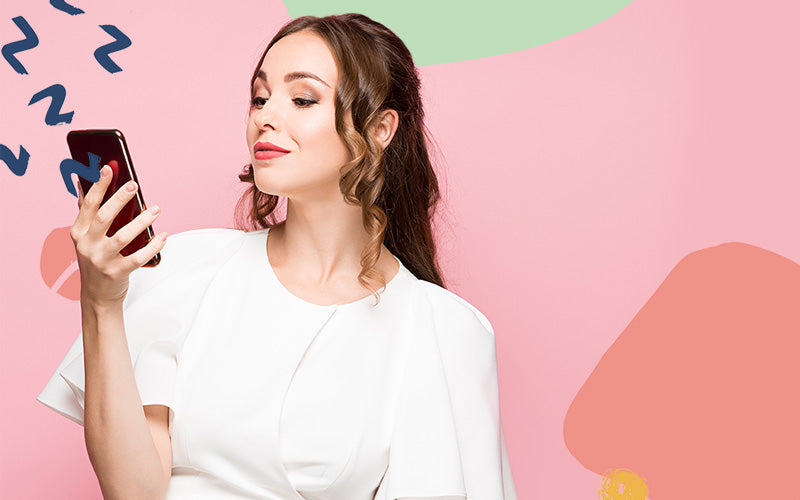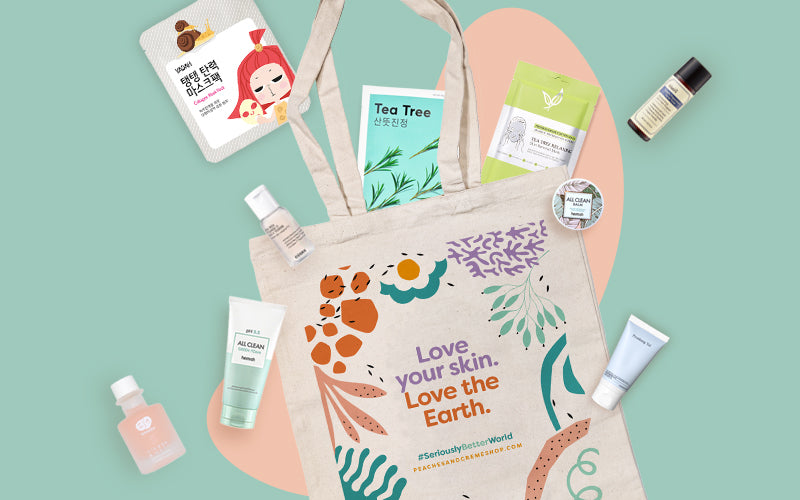Acne Series 5: Acne-fighting skincare ingredients

Acne is a notorious skin concern that many of us struggle with regardless of age. In the endless sea of anti-acne products out there, we understand that finding the right skincare for YOU can get overwhelmingーbut you don't have to worry. Here’s a quick guide on the best acne ingredients to help you choose your acne products.
1. Salicylic Acid
If you follow or read about skincare, then you've probably heard of salicylic acid. This acne-fighting ingredient is a beta-hydroxy acid (BHA)ーa pore-cleaning exfoliant. It is oil soluble which enables it to deeply penetrate into the pores to unclog them. This reduces the number and size of blackheads and helps rid your skin of excess oil to prevent new pimples.
Salicylic acid also acts as a keratolytic agent which removes the top layer of dead skin cells and allows the scaly, thickened plaques of your skin to shed more easily. It is a chemical exfoliator that promotes cell turnover, refreshes your skin, and helps kill bacteria.
This is a well-loved skincare ingredient that is also useful for oily skin types and those with clogged pores because it can help soothe inflammation and calm redness.
How to use:
You can use salicylic acid in a cleanser, gel, moisturizer, or cream. It should be applied once or twice a day, depending on the product you are using so make sure to read the label for suggested use.
A higher concentration of salicylic acid does not mean it will be more effective. You will likely see concentrations ranging from .5% to 5%, but dermatologists recommend 1% to 2%. With this percentage, you may notice that your acne won't disappear immediately. However, it will definitely prevent clogged pores (which is the main cause of acne!).
At a low concentration of 2%, this chemical exfoliant can be tolerated by all skin types but may possible dry your skin. If salicylic acid is too harsh for you, try products with Betaine Salicylate, a BHA which is more gentle compared to salicylic acid.
When using salicylic acid, you'll see results in one to two weeks.
Our product recommendations:
- COSRX BHA Blackhead Power Liquid
- Kaine Rosemary Relief Gel Cleanser
- Hanskin BHA Pore Cleansing Balm and Pore Cleansing Oil
- Purito AHA BHA Refreshing Solution
- BOJ Green Plum Refreshing Toner : AHA + BHA [Renewed]
2. Retinoid/Retinol
Retinoid is a vitamin A derivative that helps regulate cell turnover rate, preventing your pores from being clogged and targeting acne before it even starts. It comes in several forms like retinol, tretinoin and adapaleneーall commonly used for treating acne.
Retinol is a type of retinoid that gets rid of the top layer of dead skin cells and promotes the growth of new collagen and healthy new skin cells. This works wonders in reducing the size and frequency of blackheads, whiteheads, and even deeper painful pimples. It doesn't stop there though! Retinol also improves the overall texture and tone of your skin.
How to use:
When it comes to retinoid and retinol, slow and steady wins the race. Make sure you start from the lowest percentage possible and gently ease your skin into it. Retinoids are great skincare ingredients but they may cause redness, itchiness, dryness, and sun sensitivity. The most common OTC retinols have a concentration of 0.1% but, if you get a prescription-strength retinoid from your dermatologist, the concentration will range from 0.025% to 1%. Your dermatologist should recommend the right concentration for you.
When starting with retinoids, use the lowest concentration once a week to reduce the risk of skin irritation. After your skin gets used to this, try applying every other night (or every third night) before slowly increasing the frequency to every day. We also recommend using retinoids after your moisturiser to help ease your skin into it. When your skin gets used to it, you can then apply your retinoid after using a cleanser and before any hydrators.
Retinols should always be applied to dry skin as applying to wet skin can increase the chances of irritation. It is also best to use retinol at night, followed by a moisturizer to combat any dryness that may occur.
Regardless of being an OTC or dermatologist-prescribed retinol, it will likely take 4 to 6 weeks or more to see results.
Our product recommendations
- Mizon 0.1% Retinol Youth Serum
- The Potions Retinol Serum
- Innisfree Retinol Cica Repair Ampoule ✨great for beginners✨
- Purito Bakuchiol Timeless Bloom Revitalizing Serum
- By Wishtrend Vitamin A-mazing Bakuchiol Night Cream
3. Azelaic Acid
Azelaic acid is an exfoliant that fights acne, treats rosacea, lightens dark spots, and removes dead skin cells. It is an underrated skincare ingredient that is both gentle and versatile.
Azelaic acid is suitable for anyone with acne-prone skin, rosacea-prone skin, hyperpigmentation, and fungal acne. In addition to being comedolytic (meaning it prevents comedones) and exfoliating deep within the pores, it is also keratolytic (decreases keratin), anti-inflammatory, and has antioxidant properties. It can be used alongside AHAs, BHAs, or retinols.
While its effects on the skin may not have been fully researched, some studies show that it may have the same effects as retinoids. How? Azelaic Acid helps regulate skin cell turnover, has anti-bacterial and anti-inflammatory effects, and possesses skin brightening properties. We weren't kidding when we said it was versatile!
How to use:
Azelaic acid can be found in leave-on topical treatments. It comes in gel, foam, and cream forms which are designed to be used on different areas of the body.
There are OTCs with concentrations at 10% or less but a prescription form of Azelaic acid can be at 15% to 20%. Apply a thin layer of the product on clean, dry skin twice a dayーmorning and night. For someone with sensitive skin, use it once every other day.
If you have AHA, BHA, or retinol in your skincare routine, use those first since they open your pores to your azelaic acid. This helps it to be absorbed by your skin faster and improves effectiveness. For those using azelaic acid in the morning, always apply sunscreen afterwards.
You should see some improvement after one week. After a full month, you'll truly see if it works for you!
Our product recommendation:
- Cos De BAHA AZ Azelaic Acid 10 Serum

4. Zinc
How is a mineral and acne related? Researchers noted in a study that participants with acne tended to have low levels of zinc, while those with minimal to no acne had normal levels of the mineral.
There are two ways zinc could potentially treat acne: oral via supplement or topical in a cream or serum.
Applying zinc can create a soothing effect and has anti-bacterial and anti-inflammatory properties to clear acne-causing bacteria. It also absorbs excess sebum and regulates the production of oil.
Zinc oxide is sometimes touted as being a good type of zinc to apply to acne-prone skinーbut there’s no research proving its worth against acne. If anything, zinc oxide’s natural consistency and opacity make it a potential pore-clogging ingredient. However, whether it will have this effect depends on how the zinc oxide is formulated. For example, the types of zinc oxide used in sunscreens are typically “wrapped” in other ingredients that improve application and keep the zinc oxide on your skin’s surface to protect it from harmful sources of light. In this situation it can’t get inside the pores where clogs start, which makes modern-day sunscreens with zinc oxide a good choice even if you have breakout-prone skin. If you're curious about INCIs, read our blog on ingredients lists here.
💡Brain treat! If you have acne-prone skin, we recommend using physical sunscreens especially when they have zinc oside as mineral filters. This combination causes less skin irritation since they sit on top of your skin as opposed to being absorbed.
How to use:
No matter which zinc supplement for acne you’re considering, be sure to consult your healthcare provider beforehand. Only a small amount of zinc is needed; taking amounts greater than 30mg per day can lead to side effects like an upset stomach and nausea. With topical products, there should be a decrease in acne within two weeks when used twice a day. When taken orally, there should be a difference in four weeks.
Our product recommendations:
- COSRX The Niacinamide 15 Serum (contains 1% Zinc PCA)
- TIA'M AC Fighting Spot Rx Cream (contains 7% Zinc)
- Neogen Dermalogy Real Niacinamide 15% Serum (contains Zinc PCA)
- COSRX Centella Blemish Cream
5. Green Tea

Green tea is good for your stomach and your skin! In the world of skincare, it is widely known for its anti-inflammatory and anti-microbial properties that help calm and soothe skin irritation alongside combating acne-causing bacteria.
Green Tea contains Epigallocatechin-3-gallate (EGCG) which is a potent source of antioxidants. How are antioxidants related to acne? It's a domino effect: oxidation of bacteria causes clogged pores which then lead to acneーand antioxidants can prevent this from happening. In addition, studies show that EGCG suppresses the growth of acne-causing bacteria on the skin.
In summary: Green tea is amazing for preventing and treating acne AND excellent in reducing sebum production. It's one of our fave skincare ingredients for a reason. 😉
How to use:
Green tea is common in all skincare productsーfrom cleansers to serums and moisturisers, you name it! This ingredient is highly suitable for oily, oily-combo, and sensitive skin types.
- Isntree Fresh Green Tea Toner and Serum
- Beauty of Joseon Calming Serum
- By Wishtrend Green Tea & Enzyme Powder Wash
- Benton Deep Green Tea Toner and Serum
- Kaine Green Calm Aqua Cream
6. Centella Asiatica
Make way for the queen and a favorite among K-beauty fans! This is the pimple-preventing medicinal herb and the go-to for those suffering from skin sensitivity and flare-ups. With its soothing benefits, this plant extract is hailed as a hydrating skin-saver and the cornerstone of K-beauty skincare rituals. Centella Asiatica is also slowly but surely capturing interest in the Western skincare world.
Centella Asiatica has many names: Asiatic pennywort, tiger grass, Brahmi, and gotu kola. It is also often labeled “Cica” in most South Korean brands.
Unlike numerous astringent acne treatments in the market, Centella Asiatica is a gentle antibacterial pimple preventerーand there are numerous studies to back it up. Studies show that this super ingredient really does have benefits for skin, thanks to its active compounds, including madecassoside, which serves as an antioxidant and can suppress acne inflammation. Centella Asiatica itself has also been shown to have potent antioxidant properties and a rich source of amino acids. There’s also research showing that it’s a good hydrating ingredient that can soothe irritated or compromised skin. In addition, there’s evidence that products with Centella Asiatica can help revitalise the skin's protective barrier and mitigate some of the visible effects of sun damage.
How to use:
Using this ingredient in the form of serums and moisturisers can be the most effective way to prevent and soothe acne.
Our product recommendations:
- SKIN1004 Madagascar Centella Ampoule ✨Highly recommended!✨
- PURITO Centella Unscented Serum and Toner (The scented versions are great too!)
- IUNIK Centella Calming Gel Cream
- COSRX AC Collection Blemish Spot Clearing Serum
- Torriden Cica Line (Cleansing gel, toner pad, and lotion)
7. Honey

Honey is a sweet ingredient for food AND skincare. It has antimicrobial properties—killing bacteria living in the skinーwhich probably explains how honey was used traditionally as a wound-healing agent in many different cultures. It is antibacterial, anti-inflammatory, and acts as an anti-fungal ingredient.
The benefits do not end there. Honey also moisturises and hydrates skin, can fade acne scars and hyperpigmentation due to its hydrogen peroxide components, soothes inflammation, and clarifies to open up pores. It even has humectant properties so it hydrates the skin while treating your acne.
Even if honey is packed with these properties, you should note that using just any type won’t completely heal acne or breakouts. However, it can play a role in diminishing the visible signs (such as redness and swelling) of acne.
How to use:
You can use honey in skincare products since they have been carefully formulated to be skin-friendly and safe to use. Honey in its natural form, as good as it sounds, may be too potent to be applied directly on your skin.
Our product recommendation:
- Skinfood Royal Honey Propolis Essence
- Haruharu Wonder Honey Green Aqua Bomb Cream
- I’m From Honey Mask
- Missha Airy Fit Sheet Mask Honey
- Some By Mi Real Honey Luminous Care Mask
8. Propolis
Propolis is a combination of tree sap and beeswax. It is an effective way to treat acne if you have sensitive, acne-prone skin.
This skincare ingredient is all about fighting off acne-causing bacteria. First, propolis is rich in flavonoids (same antioxidant found in coffee) and has antiseptic characteristics. It then moisturises and hydrates your skin which it become healthier and more capable of combatting bacteria. Lastly, propolis controls sebum production which is important in preventing acne-causing bacteria from thriving in your skin.
Propolis also helps in the aftermath of a breakout: the dreaded acne scars and hyperpigmentation. The healing properties of propolis will help ease the redness of your skin, speed up its recovery from scarring, and heal your skin.
How to use:
It's best to use propolis through serums and essences so that your skin can easily and quickly absorb it.
Our product recommendations:
- Beauty of Joseon Glow Serum
- Iunik Propolis Vitamin Synergy Serum
- By Wishtrend Polyphenol in Propolis Ampoule
- Some By Mi Propolis B5 Glow Barrier Calming Serum
- COSRX Full Fit Propolis Light Ampoule
9. Tea Tree
Tea Tree oil has been used to heal wounds and aid with minor illnesses for centuries. When it comes to skincare, however, its anti-bacterial and anti-inflammatory properties may help in preventing acne.
It's thought to calm redness, swelling, and inflammation. It may even help to prevent and reduce acne scars for smooth, clear skin. Although it may be effective, tea tree oil can cause irritation and may even worsen acne and your overall skin condition especially if you are sensitive to essential oils. We say may because the studies supporting tea tree are small and much lower in quality compared to the research done for other acne-fighting ingredients.
Despite this, several studies have shown that tea tree oil is just as effective as benzoyl peroxide at reducing the severity of acneーbut it takes longer to see the same results. Compared to benzoyl peroxide, tea tree oil is much more gentle and less irritating to the skin. It can also be used alongside skin-clearing ingredients like mild AHAs and BHAsーthink glycolic or salicylic acidーfor a holistic treatment if you have easily clogged skin.
In addition, tea tree is a powerful antioxidant and benzoyl peroxide is not. What’s more is that benzoyl peroxide can lead to free radical formation, so the spot may go quicker, but this ingredient will likely irritate the skin surrounding the spot and possibly create particles that can lead to skin cell damage.
How to use:
This is a skincare ingredient best for those with inflammatory acne and oily skin, and NOT for sensitive skin types.
Use skincare products already containing tea tree oil since they have been carefully formulated to be safely used as directed. DO NOT USE 100% tea tree oil! Tea tree oil as an essential oil should not be applied straight to the skin because it can cause a rash.
Our product recommendation:
- Iunik Tea Tree Relief Serum
- Vegreen Skin Purifying Tea Tree Serum
- Some By Mi AHA BHA PHA 30 Days Miracle Toner
- SKIN1004 Tea Tree Cica Purifying Toner and Ampoule
- Mary&May Vegan CICA Tea Tree AHA PHA Blemish Toner
10. Mugwort

Mugwort or Artemesia Princeps does wonders for irritated skin. Mugwort is a weed and Artemesia, its genus, also includes wormwood. It is a healing Korean herb that has antibacterial, anti-fungal, and skin protection properties. Today, you can see a lot of Korean skincare products that include Mugwort in their formulation because of its soothing, calming, and anti-inflammatory properties.
In addition, mugwort is ideal for mature skin because of its smoothing and antioxidant properties which help repair sun damage. It also stimulates the production of collagen in your body, reduces the appearance of fine lines, and brings out that youthful glowーmaking your skin look radiant and healthy.
Although mugwort has not been proven to treat or work on acne yet, it has been proven to help decrease inflammation and kill bacteria. This powerful synergy has great potential in treating breakouts.
Our product recommendations:
- I’m From Mugwort Essence
- Axis-Y Mugwort Pore Clarifying Wash-Off Pack
- Isntree Spot Saver Mugwort Gauze Mask
- Isntree Mugwort Calming Clay Mask
- Round Lab Mugwort Calming Toner
11. Sulfur
Sulfur can sound intimidating but it's actually our friend! This acne-fighting skincare ingredient reduces the frequency of both blackheads and whiteheads as it removes the top layer of skin cells, which then unclogs pores. Additionally, sulfur can decrease the redness and size of pimples.
A 2009 review published in Clinical, Cosmetic and Investigational Dermatology stated that sulfur was effective as a drying and antibacterial agent for acne and that it was suitable for sensitive skin.
How to use:
Sulfur is available in cleansers, masks, or spot treatments that are meant to be applied on problem spots only. You should also use products with concentrations at 3% to 5%. Spot treatments can improve the appearance of pimples in just a few days but using a less concentrated cleanser can take a couple of weeks to show results.
12. Niacinamide
This beloved and well-known skincare ingredient offers a bevy of benefits for your skinーacne-fighting included.
Niacinamide is a type of vitamin B3 that is water-soluble, and a versatile skincare ingredient which helps keep your skin healthy and glowing. Niacinamide is popular for its skin brightening properties and how it helps reduce hyperpigmentation and redness. It also boosts collagen production which, in turn, smoothens your skin and improves fine lines and wrinkles.
But how does niacinamide help fight acne? First, it is calming and anti-inflammatory. This helps reduce the size and redness of your acne. In addition, niacinamide helps regulate and lessen the production of sebum which is a major contributor when it comes to breakouts.
How to use
Niacinamide is friendly to your skin and other skincare ingredients as it can be paired with mostーespecially salicylic acid, retinol, and centella asiatica. For a more comprehensive list of skincare ingredients to mix and not mix, check out our guide here.
Our product recommendations
- ONE THING Niacinamide 10% Toner
- TIA'M Vita B3 Source Serum
- COSRX The Niacinamide 15 Serum (also contains 1% Zinc PCA)
- Neogen Dermalogy Real Niacinamide 15% Serum (also contains Zinc PCA)
13. Heartleaf (Houttuynia Cordata)
Heartleaf has been a rising star in acne-fighting skincare since 2021. It has been used for its medicinal and healing properties traditionally−especially for its antioxidant and anti-inflammatory benefits.
Scientifically known as Houttuynia Cordata, its skincare benefits include reducing acne, soothing irritated skin, and helping to moisturise skin as it is also a humectant. Now, let's focus on its acne-fighting benefits! Heartleaf regulates sebum production which, as we discussed, is one of the driving forces behind breakouts. It is also anti-bacterial so it adds an extra layer of acne-prevention. In addition, heartleaf is non-comedogenicーit won't clog your pores.
If you are already in the throes of an acne breakout, heartleaf's anti-inflammatory properties come into play to help reduce acne and calm your skin. It also helps protect your skin barrier through its moisturising effect.
How to use
Make sure to use heartleaf only when included in skincare products. This gives you the assurance that it was formulated to be skin-friendly.
Our product recommendations
- Axis-Y Heartleaf My Type Calming Cream
- Abib Heartleaf Spot Pad Calming Touch
- Mixsoon Heartleaf Essence
- Ma:nyo Our Vegan Heartleaf Cica Serum
- Goodal Houttuynia Cordata Calming Moisture Cream
14. Azulene
Azulene is derived from plants and herbs like chamomile, yarrow, and wormwood. It gets its name from the Spanish word "azul" because of its blue color.
Coming from chamomile and yarrow, azulene is known for its anti-inflammatory, anti-microbial, and healing propertiesーbenefits that are essential when it comes to fighting acne. This means azulene can help soothe red and irritated skin, curb the growth of acne-causing bacteria, and protect your skin from damage.
How to use
As a botanical and essential oil, it is best to use azulene oil when already formulated into skincare products. Do not use it directly (like tea tree oil!) to lessen the risk of skin irritations.
Our product recommendation
- Dr. Althea Azulene 147HA Intensive Soothing Cream
- dear, Klairs Midnight Blue Calming Cream (trust us, this is the miracle worker for acne-prone skin!)
15. Calamine
Calamine is used to relieve itchiness, redness, and inflammations. You can get it over-the-counter (OTC), often as a topical cream or lotion.
This skincare ingredient is actually formulated with our old friend (a few numbers up in this guide) zinc oxide. Its anti-inflammatory properties, paired with calamine being an astringent, means an effective punch against acneーspecifically in terms of reducing their sizes.
However, calamine is not a stand-alone treatment against acne. You will need to supplement it with other acne-fighting ingredients to get to the root of the problem and to prevent future breakouts.
How to use
When applying calamine to acne, use a small amount and press it to the area using a cotton pad. It's recommended to do this at night before bed. If you have sensitive skin, we recommend doing a patch test or consulting your dermatologist before use.
Our product recommendation
Bonus Round: More Acne-Fighting Heroes
Mixing and matching skincare products and ingredients can get confusing, especially when you're dealing with acne and the aftermath of a breakout. To help you out, we recommend the Axis-Y Spot the Different Blemish Treatment. This light gel is packed with skincare ingredients that can help you treat, recover, and prevent acne. Here's a quick breakdown of the acne-fighting ingredients it contains:
- Tea Tree Extract - helps soothe skin and reduce irritation while drying out blemishes and breakouts
- Camphor Leaf Extract - boasts anti-inflammatory, antibacterial, and antifungal effects PLUS skin brightening and antioxidant properties
- Licorice Root Extract - helps brighten and soothe inflammations, irritation, and redness
- Green Tea Leaf Extract - powerful antioxidant that soothes skin and helps improve discoloration, repair damage, and reduce sebum production
- Mentha Aquatica - revitalises and rejuvenates skin to help soothe irritation and leave you with a refreshed feeling
- Breadleaf Bamboo - has anti-inflammatory properties and helps strengthen skin barrier while providing moisture to your skin
In addition, do not pick at or scratch acneーpatch it! You can use pimple patches like the Some By Mi 30 Days Miracle Clear Spot Patch to protect and help it heal.
When to see a dermatologist

Although there are product recommendations as well as product and ingredient guides readily available everywhere, if your acne does not show improvement after trying over-the-counter treatments and skincare products, you should go and see your dermatologist. They will be able to come up with a more effective skincare routine and treatment or prescribe you stronger oral and/or topical treatments to help your skin get better.
Remember, Peaches: it's always best to know what your skin needs to help it recover and regain its healthy glow!









Leave a comment